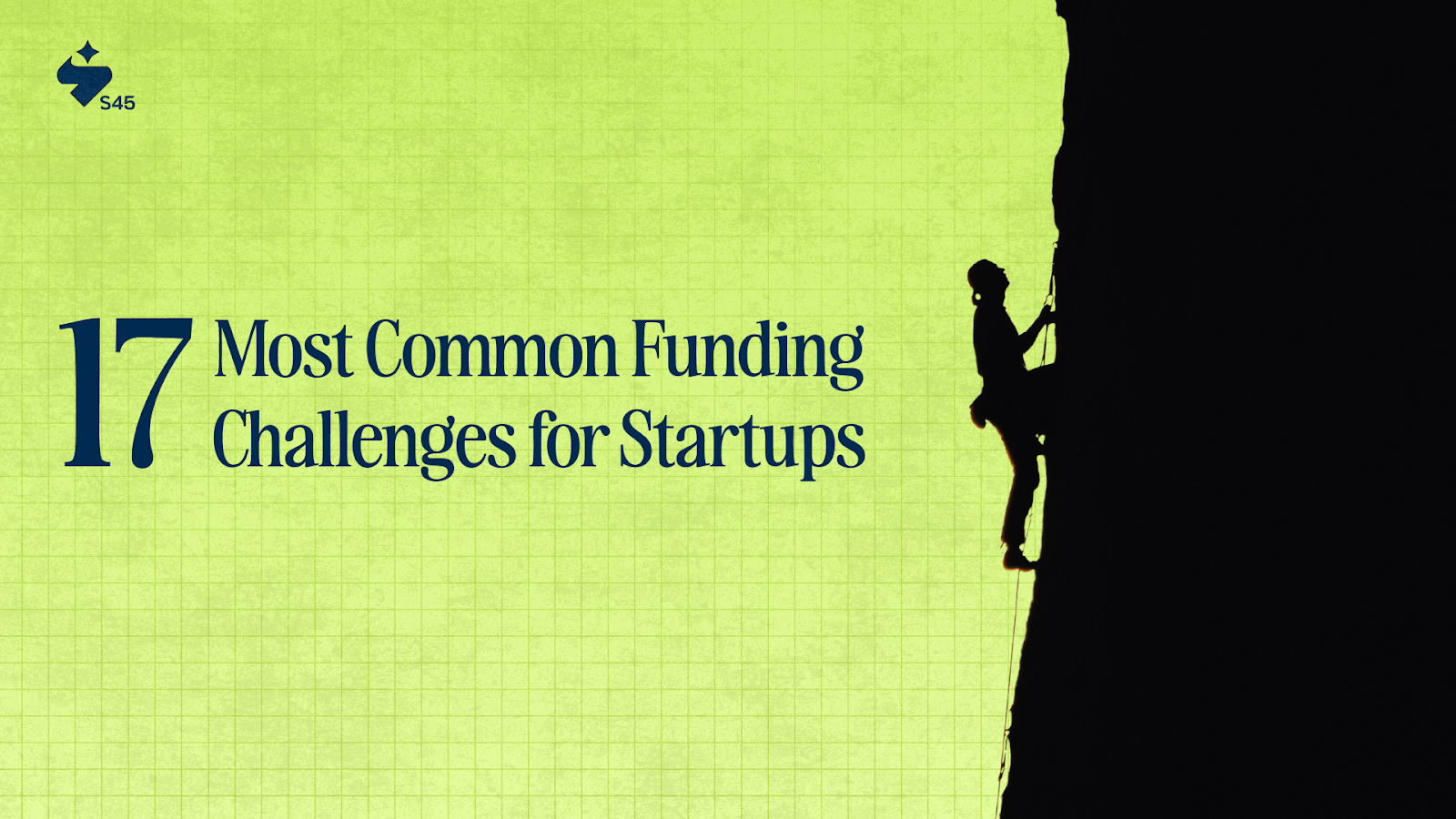
Key Takeaways:
- Funding challenges are specific obstacles that prevent profitable businesses from accessing the right capital at the right time.
- Knowing these challenges helps you prepare documentation, target appropriate investors, and negotiate better terms before problems arise.
- Preparation saves months of wasted time, reduces legal costs, and gives you negotiation power during fundraising discussions.
- Cash flow gaps hit even profitable businesses when expansion investments happen months before revenue returns materialize.
- Valuation becomes subjective without perfect industry comparables, creating friction between founder expectations and investor offers.
Disclaimer: This content is for educational purposes only and should not be considered as financial advice. Every business situation is unique, and we recommend consulting with qualified financial advisors before making important business decisions.
According to recent data, global startup funding hit $91 billion in Q2 2025, marking an 11% rise from the previous year. This shows that capital is available, but accessing it requires the right approach and preparation.
Getting funding as a profitable, growing company brings unique opportunities and challenges. In this guide, we walk through 17 specific funding obstacles that growth-stage businesses face and give you effective ways to solve each one.
By the end of this guide, you'll know how to prepare for fundraising, avoid common mistakes, and find investors who actually understand your business model. Let’s get started!
What Are the Funding Challenges for Startups?
Funding challenges are specific obstacles that prevent businesses from getting the capital they need to grow. These aren't just about having a good idea or finding investors. They're actual problems that happen during the fundraising process itself.
For example, a profitable manufacturing business with 40% annual growth might struggle to raise capital because VCs see it as too traditional, private equity sees it as too small, and banks see it as too risky.
The business is healthy, but it doesn't fit standard investor categories. This mismatch creates funding challenges that require specific solutions. Let’s see why knowing about these challenges is important.
Why Knowing About Funding Challenges Is Essential for Startups?

Successful fundraising requires preparation. Many profitable businesses fail to raise capital because they don't think about the specific obstacles they'll face or prepare solutions in advance. Here’s why it’s worth it to know about the funding challenges:
- Preparation advantage: Knowing what investors will ask for lets you organize documentation and systems before you need capital.
- Negotiation power: The valuation methods and deal structures help you negotiate better terms and avoid unfavorable agreements.
- Time efficiency: Targeting the right investor types from the start saves months of pitching to misaligned capital sources.
- Cost control: Proper preparation reduces legal fees, accounting costs, and other fundraising expenses that can add up quickly.
- Strategic timing: Knowing market cycles and investor preferences helps you time your fundraising for maximum success.
Funding challenges become easier to handle when you partner with experts who have already successfully helped other startups in the funding and growth process. S45 works specifically with profitable, growing businesses that need strategic expansion capital and guidance while preserving founder control.
Now, once you know why funding challenges happen, you can approach fundraising strategically rather than reactively. Let’s look at some of the most common challenges and how you can overcome them effectively.
17 Most Common Funding Challenges for Startups
Every startup faces unique funding challenges, but certain patterns emerge consistently across industries and stages. Here are the most common challenges and practical ways to address each one.
1. Cash Flow Timing Mismatches
Cash flow problems aren't always about being unprofitable. Growing businesses often face timing gaps between when they need to invest in expansion and when they see returns from those investments.
For example, if you're expanding into new markets, you need upfront capital for hiring, marketing, and infrastructure. But revenue from these investments might not materialize for 6-12 months. Meanwhile, existing customers might pay on 60-90 day terms, creating working capital pressure.
The solution is building detailed cash flow projections that show exactly when you need capital and when you expect returns. Include seasonal variations, customer payment patterns, and expansion timeline assumptions. This preparation helps you request the right amount of funding at the right time, rather than scrambling when cash gets tight.
2. Lack of Comparable Company Data
Investors rely on comparable companies to evaluate risk and potential returns. But if you're in a newer market segment or have a unique business model, finding relevant comparables becomes difficult. Without clear comparables, investors struggle to understand your growth potential and valuation.
Address this by creating multiple comparison frameworks. Look at companies with similar revenue models, even if they serve different markets. Find businesses with comparable unit economics or customer acquisition patterns.
Build financial models that show how your business compares across different metrics and explain why certain comparisons are more relevant than others.
3. Investor Stage Misalignment
Different investors target different business stages, but these categories don't always match real business development patterns.
For instance, VCs want businesses that can scale 10x in 5-7 years. Private equity targets established companies they can optimize and exit. Banks prefer predictable cash flows with solid collateral.
The solution is targeting investors who specifically understand your stage and model. Look for growth equity firms, revenue-based lenders, or strategic investors in your industry. Prepare different presentations for different investor types, emphasizing the metrics and outcomes each category cares about most.
4. Extensive Due Diligence Requirements
The due diligence process can consume months of management time while you're trying to run and grow your business. Investors want detailed financial statements, customer contracts, legal documents, operational metrics, and strategic plans.
Start preparing for due diligence before you need to raise capital. Implement proper financial reporting systems, organize legal documents, and create management dashboards that track key metrics. Having this infrastructure in place makes fundraising faster and shows operational sophistication to potential investors.
5. Valuation Methodology Disagreements
Valuation becomes subjective when standard methods don't apply cleanly to your business. Revenue multiples work if you have comparable companies. But it becomes a challenge when your industry lacks enough public companies for reliable benchmarks.
To overcome this challenge, prepare multiple valuation approaches using different methodologies. Show revenue quality differences between recurring and project-based income.
Present scenarios for different growth rates and market conditions. Having a thorough analysis shows sophistication and provides multiple perspectives for negotiation.
6. Limited Financial Operating History
Even profitable businesses can struggle if their financial history doesn't clearly demonstrate sustainable growth patterns. You might have been profitable for only 12-18 months. Your accounting systems might have changed as you grew. Previous losses might obscure current profitability trends.
Seasonal businesses face particular challenges because 2-3 years of data might not show enough complete cycles. Businesses that reinvest heavily in growth might show lower historical profits than their current earning potential suggests.
The solution is building forward-looking financial models that explain historical patterns and project future performance. Include explanations for accounting changes, one-time expenses, or seasonal variations. Show unit economics and scalability metrics that demonstrate sustainable profitability beyond historical results.
7. Regulatory and Compliance Complexity
Industry-specific regulations can complicate funding processes, especially for investors unfamiliar with your sector.
Additionally, international operations multiply compliance requirements. If you serve international customers or plan geographic expansion, regulatory requirements in different jurisdictions affect growth potential and investment risk.
Address regulatory concerns proactively by documenting current compliance status, required approvals for growth plans, and regulatory risk mitigation strategies. Work with compliance experts who understand your industry and can explain regulatory frameworks to potential investors.
8. Market Timing and Economic Sensitivity
External economic conditions significantly influence funding availability and terms, often beyond your control. During economic uncertainty, investors become more conservative and favor businesses with predictable cash flows over growth potential.
To handle this, build financial models that show performance under different economic scenarios. Demonstrate recession resilience or counter-cyclical characteristics if applicable. Focus on business fundamentals and operational efficiency rather than market timing when presenting to investors.
9. Geographic Market Limitations
Many investors prefer businesses in major metropolitan areas or specific regions. If you're building outside traditional startup hubs, or if your target market is in smaller cities, you might struggle to find investors who understand your local market advantages.
To address this, emphasize scalability potential and transferable business model elements. Show how local success can be replicated in similar markets. Consider targeting investors with regional focus or industry expertise rather than geographic preferences.
10. Team and Management Gaps
Institutional investors typically require specific management capabilities before providing growth capital. So, you’ll need a CFO for financial systems, a CTO for technology scaling, and a COO for operational efficiency.
But the challenge is that hiring senior executives requires capital. To handle this, address team gaps through advisory relationships, fractional executives, or hiring plans included in funding requests. Show how additional capital will enable key hires and what specific capabilities these additions will provide. Consider bringing on advisors or board members who fill experience gaps.
11. Customer Concentration Risk
If a significant portion of your revenue comes from a small number of customers, investors worry about business sustainability. Losing one major customer could dramatically impact financial performance.
To overcome this, demonstrate customer diversification plans and relationship strength with major accounts. Show pipeline development for new customer segments.
Emphasize contract terms, renewal rates, and expansion opportunities within existing accounts. Additionally, build financial models that show the impact of losing major customers and recovery plans.
12. Technology and Innovation Requirements
Even non-tech businesses need technology capabilities to scale efficiently. Your manual processes might work at the current scale, but they could also require automation and upgradation to handle increased volume or complexity.
Investors often want to understand technology requirements and costs for scaling your business. They might worry about technical debt, system limitations, or competitive disadvantages from outdated technology.
So, create technology roadmaps that show current capabilities, scaling requirements, and investment needs. Show how technology improvements will enable growth, improve efficiency, or create competitive advantages. Consider partnerships or acquisitions that provide technology capabilities without internal development costs.
13. Competitive Advantage
Investors also like to understand your competitive advantages and barriers to entry. If your business relies on relationships, processes, or local market knowledge rather than proprietary technology, explaining sustainable competitive advantages becomes more complex.
Service businesses might have excellent reputations and customer relationships, but few tangible intellectual property assets. Local businesses might have strong market positions that appear vulnerable to larger competitors.
To handle this, document competitive advantages like customer relationships, proprietary processes, regulatory barriers, or market positioning. Emphasize management expertise and operational capabilities that competitors would struggle to replicate.
14. Exit Strategy Uncertainty
Institutional investors also analyze how they'll eventually realize returns on their investment. If you're building a lifestyle business or planning to maintain family ownership, traditional exit strategies might not apply and can create a challenge.
Discuss alternative exit structures like management buyouts, dividend recapitalization, or secondary sales to other investors. Show comparable transactions in your industry and explain the valuation methodology for future exit scenarios. Consider investor types that don't require traditional exits.
15. Working Capital Scaling Requirements
As your business grows, working capital requirements typically increase. But the working capital increases can strain cash flow even as profitability improves.
Investors need to understand capital requirements for growth and how additional funding will support scaling rather than just current operations.
So, build detailed working capital models that show requirements at different revenue levels. Show how additional capital will enable growth while maintaining healthy cash flow ratios.
16. International Expansion Complexity
If your growth strategy includes international expansion, investors would also like to understand market entry costs, regulatory requirements, and execution risks.
International growth can provide significant opportunities, but also multiply operational complexity. Currency risk, local competition, regulatory differences, and cultural adaptation all affect international expansion success. Your domestic success might not translate directly to international markets.
To overcome this challenge, create detailed international expansion plans with market research, regulatory analysis, and financial projections for each target market.
Consider partnerships with local companies or investors who understand specific international markets. Show scalable business model elements that can be adapted for different markets.
17. Capital Efficiency and Use of Funds
Investors want to understand exactly how you'll use their capital and what returns they can expect. Vague plans for growth capital or working capital don't provide enough detail for investment decisions.
You need to show specific use of funds, expected outcomes, and a timeline for results. Capital efficiency metrics like return on invested capital, customer acquisition costs, and unit economics become important evaluation criteria.
So, to effectively handle this, create detailed use of funds analyses that show specific investments, expected returns, and a timeline for impact. Break down capital requirements by category and show how each investment will drive business growth.
Final Thoughts
Funding challenges for startups are complex, but they're not impossible to solve. The most successful founders focus on building strong operational fundamentals, like predictable revenue, efficient systems, and clear growth strategies, before thinking about funding trends or investor preferences.
Building something lasting takes patience, strategic thinking, and partners who understand your vision. Don't let funding challenges compromise the business you've spent years building.
The right capital partner will help you scale while preserving what makes your business special. S45 helps growth-stage businesses handle capital challenges while building a business for long-term success.
FAQs
1. What are the biggest funding challenges for profitable startups?
Profitable startups often face investor stage misalignment and valuation complexity. Most investors expect either high-risk growth plays or acquisition targets, while profitable businesses need expansion capital for strategic growth.
2. How can startups improve their chances of securing growth funding?
Focus on building sophisticated financial reporting, clear expansion strategies, and relationships with stage-appropriate investors. Prepare detailed business models and consider alternative structures beyond traditional equity rounds.
3. What should startups do if traditional VCs don't understand their business?
Explore growth equity firms, revenue-based financing, strategic investors, or specialized funding partners. Many successful businesses find better alignment outside traditional VC structures.
4. How long does fundraising typically take for growth-stage companies?
Growth-stage fundraising usually takes 4-8 months from preparation to closing. However, building investor relationships and organizing documentation should start well before you need capital.
5. What valuation methods work best for unique business models?
Use multiple approaches, including revenue multiples, cash flow analysis, and market comparisons. Focus on demonstrating sustainable unit economics and growth patterns rather than just current financial metrics.


